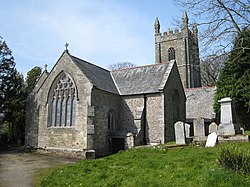Kenwyn
| Kenwyn | |
| Cornwall | |
|---|---|
 St Kenwyn's Church | |
| Location | |
| Grid reference: | SW818453 |
| Location: | 50°16’5"N, 5°3’47"W |
| Data | |
| Post town: | Truro |
| Postcode: | TR1 |
| Local Government | |
| Council: | Cornwall |
Kenwyn is a village in Cornwall, which has become a western suburb of the City of Truro. It stands half a mile north of the city centre and gives its name to one of three rivers that flow through the city: the River Kenwyn.
History and name
The name of the village is rendered in the Cornish language as Keynwynn, and comes from the dedication pf the parish church, or the local topography: there is no agreement.
It is likely that the church of Kenwyn is very early and in fact the mother church of Truro. The original dedication is doubtfully St Keyne (Keynwen is the earliest form of the name which would be 'Keyn' and -wen' (white/blessed): by the 15th century it was assumed to be St Kenwyn (no mediæval records have it with the prefix 'Saint'). Subsequently the dedication was attributed to St Cuby.[1]
The earliest form of the name is Keynwen (1259), which, it is argued, is from the Cornish words keyn and gwen, meaning "White ridge",[2] but the modern Cornish form has been interpreted as "Splendid Chief".

The manor of Kenwyn was held in the 12th century by Richard de Luci after it had been confiscated by the King. Apparently the borough of Truro was established by the lord in part of the manor and this was the beginning of Truro as a town, then called Triuereu.[3]
In Domesday Book the manor of Kenwyn appears as Tregavran (in later usage Trehaverne). It was in the possession over many centuries of the families of Lantyan, Beville and Grenville, and Enys.[4]
Parish church and bishop's palace
Kenwyn Parish Church is more or less 14th and 15th century in date: (south aisle and tower 15th century). Restorations (1820 to 1862) have reduced the interior to its present uninteresting state. There is a peal of eight bells.[5] The churchyard provides a fine view over the city of Truro and above the lychgate is an upper chamber (probably a schoolroom).
Lis Escop in Kenwyn is the official residence of the Bishop of Truro: the name is Cornish of "Bishop's Court" or Palace. It was built in 1780 to serve as the vicarage of Kenwyn, and became the bishop's palace after the establishment of the Diocese of Truro.[6] For some years it housed part of Truro Cathedral School (closed 1981) then the Community of the Epiphany, an order of Anglican nuns. It is now, as Epiphany House, a Christian retreat and conference centre.
Outside links
| ("Wikimedia Commons" has material about Kenwyn) |
References
- ↑ Cornish Church Guide (1925) Truro: Blackford; p. 117
- ↑ Ekwall, Eilert (1940). The Concise Oxford Dictionary of English Place-names (2nd ed.). Oxford [Eng.]: Clarendon Press. pp. 260. ISBN 0-19-869103-3.
- ↑ Halliday, F. E. (1959) A History of Cornwall. London: Duckworth; p. 112
- ↑ Henderson, C. (1935) Records of the Borough of Truro before 1300, in Essays in Cornish History, edited by A. L. Rowse and M. I. Henderson. Oxford: Clarendon Press; pp. 1-18
- ↑ Dove, R. H. (1982) A Bellringer's Guide to the Church Bells of Britain; 6th ed. Aldershot: Viggers; p. 111
- ↑ Nikolaus Pevsner: The Buildings of England: Cornwall, 1951; 1970 Penguin Books ISBN 978-0-300-09589-0 pages 84-85
